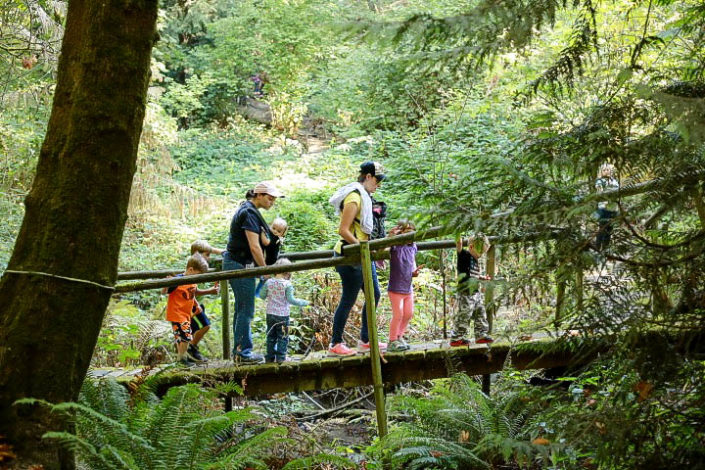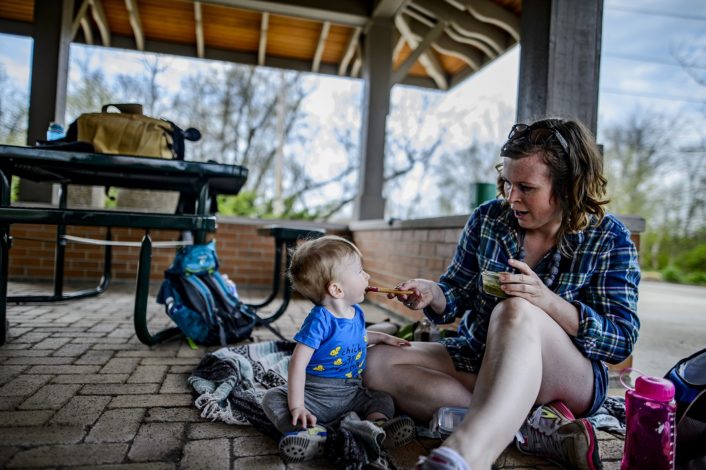First time hiking with kids? Helpful tips to get out on trail
Originally posted January 2018.
When we start something new, we tend to need extra help. Heck! When my family returns to something we know after an absence, we seem to forget everything we knew. So whether it's your first time hiking with kids, or you're a returning or a seasoned hiker, I bet there's a tip here you can use.
We asked our very own Hike it Baby community of hikers, "what do you wish you knew the first time you went hiking with kids?" and here are the replies - a fantastic list of tips to get out on the trail. First of all, remember, not every tip will be right for you, your family or the way and places you hike. Take what you like ... leave the rest. No worries.

Tips on What to Pack
- A magnifying glass makes for awesome discoveries.
- Bring a grocery bag or two. Fold them up and tuck them into a pocket of your pack. Dirty Diaper? Bag. Muddy shirt? Bag. Starts to rain on your camera? Bag. You get it.
- Pack a bug net or spray. Nothing makes changing a diaper harder than a horde of pests.
- Wipes always come in handy. You may find them useful for older kids, too, or yourself. We tuck a handful in a ziplock bag. It keeps them moist without having to carry a whole bucket of them.
- Bring an extra outfit for baby in case of a blowout. And also, layers to shear off and tie around your waist as you warm up. A bag in the car can be helpful with a change for each person. I can't recall the number of times I ended up in the creek unexpectedly and was SO thankful for that change of pants to drive home in.
- Pack extra water. If the kids are old enough, get them to carry their own CamelBaks and still have a bottle in the car for after. You can always drop it in the fridge if you don't use it, but will be sad if you end up needing it.
- Have a Pull-Up for potty training littles. It can save your day if they need to be carried and fall asleep while on your back (or, a change of clothes for you if Pull-Ups aren't in your potty training strategy).
- If you feel like you might need more stuff, pack it in the car and decide when you get there. Sometimes less is more, especially if the car is close by.
- Don't over pack. We ditched the entire diaper bag for two diapers and a bag of wipes tucked into the CamelBak. We never took the babies on a hike that was long enough for more than the two diapers.
- Have walking kids? Pack the carrier in the car, even if you don't expect to use it. Better safe than sorry, or rather, tired because you had to carry the toddler who you thought would walk.
- Learn what your family's essentials are and leave the rest at home (or in the car). In a pinch, there is likely a hiking friend who has what you need.
- Pack cozy slippers (or flip flops) for post-hike driving. The times I was able to slip off my rain boots and have dry, free toesies on the way home? Priceless.
Tips While on the Trail
- Don't be afraid to hike at nap time. A sleeping baby can leave you free to explore or hike a faster pace if you like.
- It's okay to go slow. It's not a failed hike if you don't make it to the end. It's the journey, not the destination. Plus, exploring can be just as rewarding.
- Expect to get dirty. Choosing not to wear the white running pants? Yeah, good choice; you don't need that level of stress on a hike. The kids will get dirty and you will get dirty; however, it'll bond you forever.
- Be patient. For your slow and exploring kids, yes. But also for you. It's OK to "call it" and give yourself permission to go home early, for any reason.
- Don't be afraid to let the little down from the carrier for a while. It will slow your progress, yes, but, as a result, you'll likely discover they're SO ready to hike like the big kids.
- For peeing on the trail, try the Holding Method. With their pants already down and their back to you, squat with them, holding the backs of their knees or under the shoulders. This body position ensures no one gets splashed.
- When back carrying, use a fanny pack worn on the front. Easy access to what you need and not in baby's way either.
- Be honest about your limits and when and how you're willing to challenge yourself and your kids.
- Snacks are your friend - while hiking and for the ride home. We quit packing "lunch" as kids tend to snack anyway. Plus, eating a snack is a great excuse to stop and take a break.

Other Helpful Tips
- Plan ahead and add a baby carrier to your registry. Include an infant AND a toddler carrier, then tuck that toddler carrier away until you need it.
- Let your kids be (reasonably) uncomfortable. "Tired feet" when you step out of the car, a scratch you know they can walk off and carrying their own pack are all things they can get used to and, therefore, will be part of the adventure. Whining is only temporary - don't let it deter you from getting out!
- Seek out the right carrier for you. You can contact your local chapter of Baby Wearing International for a quick, concise assist with this. For a hard-framed carrier, go to an outdoor store and try on a few different models to see which fits you and your little one best.
- Start small. If you only have 10 minutes to hike, use it! Do it regularly, and when you feel ready, increase the time and distance. No one says you have to start with the 10-mile trek, uphill, both ways, in the snow.
- If hiking on your own (with or without kids), think of safety. Does someone know you're hiking and where? Is your phone charged? Will you even have coverage where you're planning to hike? What would you do if you strained your ankle? Make a quick plan, just in case.
- Try doing a little "re-con" first and plan to just wander a little on a new trail, get to know the terrain and get a feel for it. Then "hike" it next time.
And finally, just go! Aside from essentials (which can change from hike to hike and from family to family), quit over-thinking and just get out there. Sure, it may not be perfect but you learn each time and the important thing is you're out there doing it.
Don't see your best tip listed for hiking the first time with kids? Comment below and help us start another list.
Read More:
- How to Prepare for the Unexpected When Hiking in the Cold
- Hiking with Young Infants: Tips and Tricks
- Top Tips for Hiking with Toddlers
Photos by Yanna Bennett and Laura Castro.
ABOUT OUTGROWN
OutGrown is a 501(c)(3) nonprofit that works to create a world where everyone can enjoy the physical and mental benefits of spending time outside. We are focused on creating opportunities and removing barriers to access so families with babies and young children can take their first steps outside. We believe all families have the right to connect with nature, benefit from spending time outdoors and be inspired to a lifelong love of nature. Since its grassroots inception in 2013, OutGrown is a growing community of 280,000 families and over 300 volunteer Branch Ambassadors. More information on all of our programs can be found at WeAreOutGrown.org
EDITORS NOTE:
We hope you enjoyed reading this article from OutGrown. We’re working hard to provide our community with content and resources that inform, inspire, and entertain you.
But content is not free. It’s built on the hard work and dedication of writers, editors, and volunteers. We make an investment in developing premium content to make it easier for families with young children to connect with nature and each other. We do not ask this lightly, but if you can, please make a contribution and help us extend our reach.
Related Content




Comments